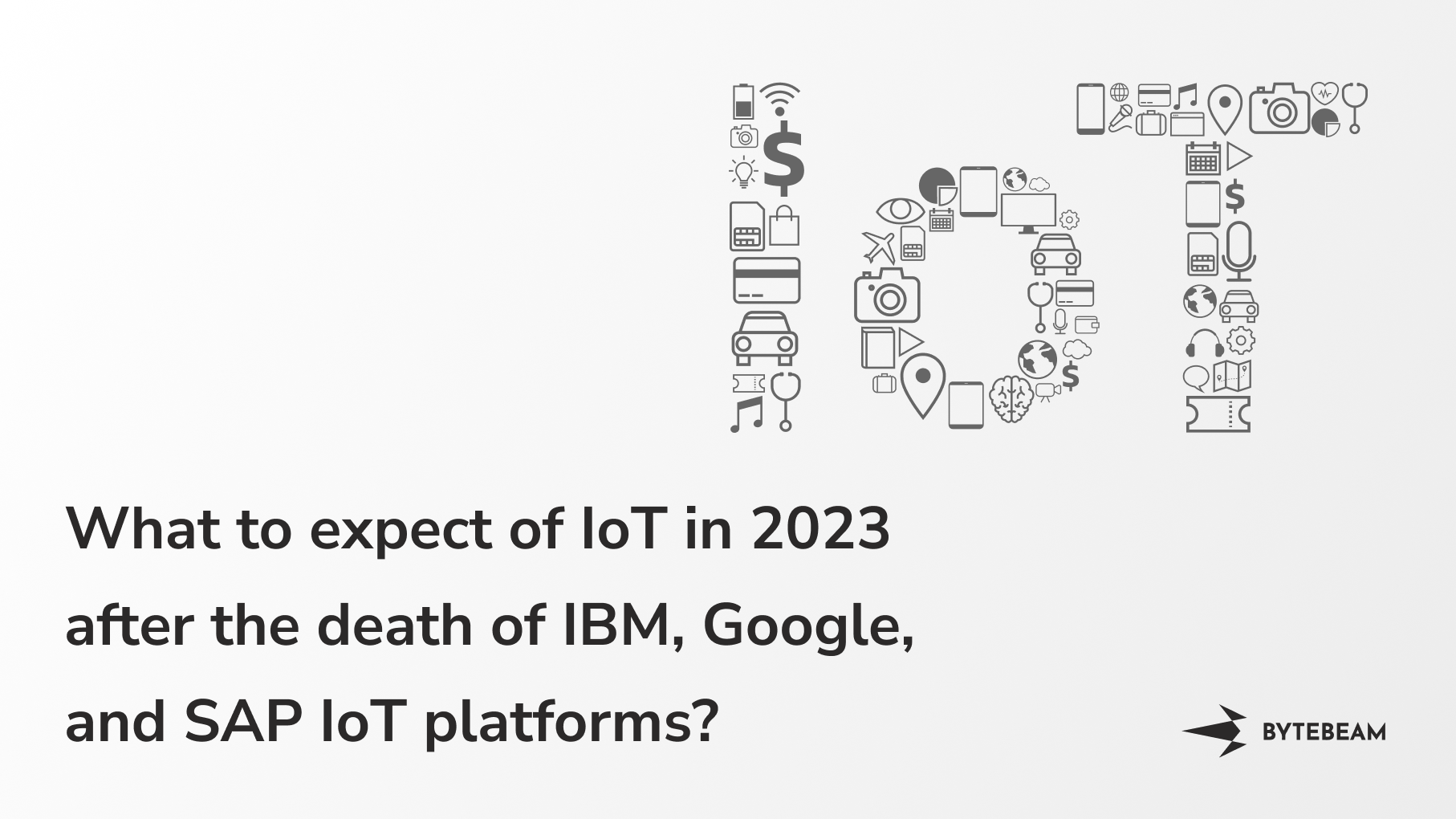What to expect of IoT in 2023 after the death of IBM, Google, and SAP IoT platforms?

We ended 2022 with some rather big strides in IoT. But not all of them were positive. In the last quarter of the year, Google, IBM, and SAP all announced that they were retiring their IoT platforms soon.
As IoT predictions look bigger and better for coming years, it comes as a shock to most. Why would these giants shut down their IoT verticals? Especially since Google and IBM have impressive amounts of market share in the industry.
Why Google, IBM, and SAP shut down their IoT platforms
The success rate of IoT projects in itself is pretty low. A recent report stated that less than 50% of all IoT projects fail. So why should IoT platforms be any different?
Although IoT platforms shut down for widely different reasons than smaller projects. And we have covered some of the most common reasons.
Customizability
No two IoT projects are the same. This means that each project will have specific and varied requirements. To fulfill these requirements, IoT platforms need to be heavily customizable.
Now let’s imagine making 100 tables. If you were to take the same design and specifications, it would be fast and cheap to make 100 tables. But what if you had to add small specifics to each table as per their users’ requirements?
This will be like creating 100 separate tables. It will take a lot more time, money, and effort, and that’s exactly what most IoT platforms deal with.
Even though larger platforms such as Google and IBM are customizable, it takes a bite out of their bottom line.
Scalability
Carrying the table example forward, if you were to keep customizing every table, it would become extremely difficult for you to scale the manufacturing from 100 to 1000. And the more table you make, the more time you spend.
Additionally, as you get bigger orders, each table in a single order may need different specifications. This will be a big obstacle for scalability and when scalability suffers, profits suffer.
Brand association
A recent blog on SAP talks about how consumers associate certain brands with specific products. For example, Kleenex with tissues, and if Kleenex were to come up with a stationery line, people would be thoroughly confused.
SAP argues that the same has been happening with IoT platforms. People associate Google with search, IBM with personal computers, and Amazon with eCommerce. Making the leap to IoT platforms can take some time. Moreover, engineering firms like Hitachi or Atos, struggle with being associated with cloud due to their native systems.
So should we expect more shutdowns?
Honestly, yes. Maybe not on the same scale as this. But a few more platforms shutting down shouldn’t be a surprise considering the way the IoT market is headed. The Gartner Magic Quadrant, which lists companies in a quadrant labeling them with niche players, visionaries, challengers, or leaders has put together the following quadrant for 2022.
This is the first time that Gartner has named any of the providers as leaders. Unsurprisingly, Microsoft Azure and AWS are both up in leader and challenger quadrants respectively. But what is fascinating, is that except for a handful of platforms, others are still in the niche segment.
So what will happen to IoT platforms in 2023?
With technology, it is difficult to predict the turns accurately. But there are some factors that can be relied upon with confidence. So given the way IoT platforms are shutting down, here is what we believe will turn out in 2023.
The rise of niche platforms
As large platforms struggle to serve a varied clientele, many businesses have already flocked to smaller niche platforms that are better suited to their requirements. Given that with platforms like Google or AWS, you anyway have to build features on top of the existing platform, it is much easier to find niche platforms that offer end-to-end solutions. Therefore, 2023 will definitely see a rise in the number and quality of niche IoT platforms.
Duopoly in enterprise IoT
Enterprise IoT is still a big players’ game, and very few enterprise projects end up with smaller platforms. Given the data and support requirements, these businesses still prefer larger players.
In light of that AWS and Azure will end up with most of the enterprise clients from Google, IBM, or SAP. This will absolutely strengthen their presence in the market further, creating a duopoly in the enterprise IoT market.
More open-sourced solutions
One of the key aspects of Google IoT core was that it allowed smaller players like enthusiasts or hobby developers to build projects on the platform with little to no investment. While AWS and Azure also have a few freemium options, the features offered are not nearly equivalent.
Given that individual programmers and hobbyists have very few avenues to experiment, newer open-sourced solutions in the IoT platforms sector are bound to come up.
Migration capabilities
With three major players shutting operations this year, there is significant concern over clients’ data. With this in mind, businesses now are looking for platforms that allow for easy migration, if need be. This is turning into a deal breaker and platforms that are already migration and integration friendly are coming out stronger.
Changes in statutory requirements
With the EU coming up with the Cyber Resilience Act, other countries won’t be far behind in terms of laying down the law for IoT products and services. This leads us to believe that IoT platforms will have to face changes in statutory requirements this year.
Final Thoughts
These changes in the industry may seem sudden or catastrophic, but they are simply paving the way for smaller and more innovative solutions which can make a big difference. If you would like to explore the benefits of working with smaller IoT platforms, feel free to reach out to us!

